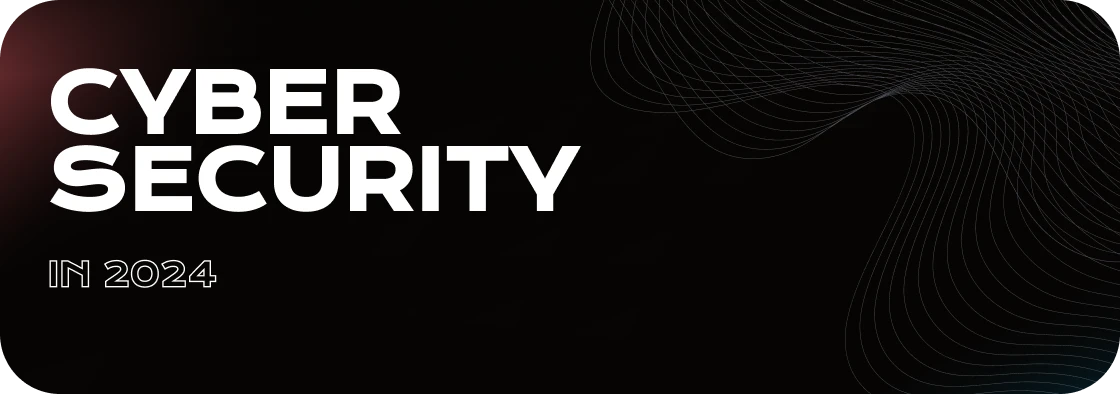With 2024, the need for cybersecurity increases: businesses are under attack on all fronts of digital threats. From complex phishing attacks to sophisticated ransomware and data breaches, modern businesses cannot afford to become complacent in keeping systems and sensitive information out of the reach of hackers. As technology continues to advance, the ways and means cybercriminals launch their attacks become more adept and prevalent, transforming robust cyber defense from an option to a business imperative in this digital age.
According to Forbes, in 2023, there were 2,365 cyberattacks with 343,338,964 victims. These are all growing threats, which indicates that cybersecurity demands an all-around and elegant approach. Today, we need solutions that keep on growing with the changing digital world. Safeguarding customer data, protecting financial transactions, or securing internal systems is in place with a well-structured cybersecurity strategy that curbs potentially devastating financial and reputational damage.
At Covent IT, we specialize in guiding organizations through the difficult world of cyber security. Our expertise ensures that no matter the industry, Covent IT is prepared to support your organization through the challenges of 2024's cyber security.
Factors Affecting Cyber Security Costs
In the year 2024, cybersecurity will be one of the most multivariate cost drivers based on various factors, all of which are going to come into critical play. Understanding these factors is important for planning and budgeting appropriate security measures for modern standards.
Increased Digitalization
The desire for interrelated systems and online services also continuously grows with every new development in the digital transformation of businesses. With this increased presence, greater surfaces open themselves up to cybercriminal attacks. Safeguarding these expansive networks, web applications, and data repositories has become more expensive due to the need for increasingly sophisticated mechanisms of defense, continuous monitoring, and timely response to different types of threats.
Compliance Requirements
One of the main driving factors in cybersecurity costs is the need for compliance with various regulations such as GDPR, HIPAA, and other industry-specific standards. In fields like healthcare, finance, and retail, extra investment may be needed to securely handle sensitive data legally. If not handled correctly, it can lead not only to regulatory penalties but also a blow to the reputation of an organization. Compliance-related measures, in turn, are crucial investments.
Emerging Technologies
The adoption of AI, cloud computing, and IoT is revolutionizing how businesses are done but also brings in new vulnerabilities. The protection of AI-driven systems, securing the cloud environment, and handling the huge volume of data generated by IoT devices demand an advanced security backbone and thus are costly. These technologies require constant updates and require specialized skill sets to ward off new and emerging threats. This further adds to the overall investment that needs to be made for effective security.
Complexity of Projects
The cost will increase with the complexity of the security project. It depends on the number of systems to be protected, the requirement to integrate on multiple platforms, and the scale at which it operates. Projects associated with several environments, like hybrid cloud environments, or projects that necessitate deep customizations of security solutions are generally so much more resource- and time-intensive that these projects add a lot to the overall cost.
Industry-Specific Needs
Still, some industries like health and finance handle very sensitive and regulated data. The specific requirements of security for such industries mostly comprised of increased stringency of controls and sophisticated mechanisms of defense. Generally, such industries require a high level of encryption, intrusion detection systems, and compliance monitoring, which raises costs as compared to industries that have fewer regulations.
Data Sensitivity
The nature of the data being protected directly impacts the cost of cybersecurity. The businesses that handle sensitive data, like personal identification, medical history, or financial information, would have to invest in advanced encryption, multi-factor authentication, and intrusion detection systems. The more sensitive the data, the more investment would be required to keep it safe from falling into the wrong hands and data breaches for misuse.
Cost Breakdown by Phase
Did you know that Statistica showed us an estimated cost of cybercrime worldwide from 2018 to 2029? If you take a look at this report, there is no wonder why it’s so important and a bit expensive to protect your data from cyber threats. Still, if you understand how cybersecurity costs are allocated to the different phases of a project, it will help you budget more appropriately and ensure that each important area of security is given the attention it deserves. Here we have prepared a detailed breakdown of key phases and the associated costs:
Planning & Assessment
First comes the deep assessment of the organization's existing state of security. This would include vulnerability assessment, penetration testing, and risk analysis. In this phase, the cost again varies since it can depend on the complexity of the network and systems being analyzed. Large organizations with various environments like hybrid cloud set-ups or IoT integrations face increased costs simply due to the breadth these assessments will cover. This generally tends to be one of the more major slices of the budget pie because it lays the foundation for everything else that happens afterward.
Implementation
This is the phase when security solutions are deployed once the vulnerabilities and their related risks are identified. The cost of deploying firewalls, intrusion detection systems, encryption technologies, etc falls under this category. Employee Training Programs are also under this category. This could be quite an expensive stage, especially when one tries to deploy high-tech solutions such as AI-powered monitoring or cloud security, depending on the size of an organization and infrastructure complexity. Furthermore, industry-specific bespoke security solutions or sensitive data security even further increase the costs.
Ongoing Monitoring & Support
Cybersecurity is not a one-time investment, but it requires constant monitoring and performance maintenance against changing threats. This includes the phase of all real-time monitoring expenses of patch management and updating security systems to handle new vulnerabilities. Organizations, very often, look at managed security services, which come with recurring fees for 24/7 support. Costs at this stage vary depending on the level of service and whether periodic audits and system updates are required.
Cost of Cyber Security for Various Project Types
By the way, cyber security can range from a low to a high level of cost, depending on the type of project and what an organization requires in terms of security. The following is an estimated cost for different types of projects that may call for various measures of protection.
Small Business Websites
For small business websites, basic security measures against malware, phishing, and website defacement should be put in place. Generally speaking, the cost becomes vastly lower since anti-malware protection, secure hosting, and basic SSL encryption are all relatively inexpensive. In a normal business website, this may be adequate, without sensitive data, and thus investment in security remains within reasonable bounds.
E-commerce platforms
E-commerce sites require higher security, given the sensitivity of the information related to PCI compliance and the protection of customer data. Protection of payment data and customers' information via encryption, multi-factor authentication that helps in the security of user accounts, and frequent penetration tests that find vulnerabilities in processing transactions all fall under this category. Ensuring the management of secure transactions is costlier than that of a simple website.
Healthcare Solutions
Healthcare solutions, such as electronic health record systems or patient portals, are another group of solutions that come under the compliance domain of HIPAA and thus require very tight security protocols and procedures in place to secure highly sensitive patient data. Key features will include secure storage of medical records, advanced encryption in data transfer and rest, and tracking system access through audit logs. Increased regulatory requirements mean care organizations have to invest much in cybersecurity for integrity and non-disclosure of data to avoid some very expensive fines.
Enterprise Solutions
Large-scale businesses, with their scope and complexity of operations, demand an integrated approach to cybersecurity. Solutions provided usually include large-scale encryption, customized firewalls, and monitoring systems with a level of sophistication that can identify threats in real-time. The enterprise may also need customized security architecture and cloud security, further adding to the cost. Apart from this, audits conducted regularly, along with compliance and employee training programs, also add up to the budget spent.
Hourly Rates versus Fixed-Price Models
It would be somewhat tricky to choose between hourly rates or fixed-price contracts when thinking about cyber security services. This would depend on the nature of the project in question and also on the level of flexibility that will be needed. Each one of these two pricing models has a respective upside and some possible downsides, which should be carefully weighed with need and budget in mind.
Hourly Rates
On the one hand, hourly rates give more flexibility and are therefore suitable for projects where the scope may evolve over a while or when support needs to be ongoing. Ongoing monitoring, real-time support, and incident response lend themselves perfectly to this. These types of services require regular updates due to the new vulnerabilities that arise. An hourly model can be advantageous in that you will only pay for time spent addressing particular issues, in cases where the demand for support may fluctuate.
On the other hand, an hourly rate can be a bit more challenging for budgeting because, until the work is finished, the final cost cannot be locked in. If the security issues prove to be more complex than initially realized, the hours piled into fixing them start to rise rather quickly, and then costs are far higher than anticipated. On longer projects, this unpredictability stretches budgets, especially if there's no estimate on a time scale.
Fixed-Price Models
Fixed price gives crystal-clear cost predictability, thus making budgeting easier for specific projects. This model is effective, in particular, when the tasks are clearly defined, such as a vulnerability assessment, pentest, or cybersecurity audit, and constrained in time. Fixed-price agreements may be comforting since you know exactly how much it will cost, no matter how much time the vendor actually devotes to your project. This model is also ideal for businesses that want a one-time engagement for a certain deliverable.
The fixed-price model has the disadvantage of less flexibility. When the scope of the project changes midway, either it leads to extra cost, or results in project delays. Vendors would also strictly abide by the agreed terms to avoid doing extra work. These types of contracts may require more detailed planning and defined requirements for given time preparation.
What’s the Right Model for you?
A hybrid model may offer the best middle ground for most companies: fixed price for clearly defined tasks and hourly rates for ongoing services like monitoring and support. This would provide cost predictability in specific areas while giving flexibility in others, and thus allow for comprehensive and adaptive cyber-security coverage.
Other Costs to Consider
Besides direct costs related to cybersecurity services, there are several other costs that a business should budget for because they have a big impact on the overall cost. Most of these other costs are often hidden or supplementary costs from third-party tooling, compliance maintenance, and security incident response.
Third-Party Software and Tools
Investment in specialized security tools and platforms adds up to be quite considerable for a cyber security budget. Advanced threat detection systems and intrusion prevention systems cost between $5,000 and over $100,000 each, depending on the size of the deployment and the level of sophistication of the tools needed. The subscription services, such as the vulnerability management tools, could fall anywhere in the range from $200 to $2,000 a month, depending on what features are involved and the level of support. These are tools that keep your security posture intact and should not be left out when budgeting.
Compliance and Certifications
Meeting industry regulations and getting necessary certifications is another big area of potential expense. For instance, the cost of compliance with such standards as ISO 27001 can range from $10,000 to $50,000+, based on the size of an organization and system complexity. Compliance audits, such as HIPAA or GDPR, range in their costs from $5,000 to $30,000+. The investment in compliance not only saves an organization from heavy fines but establishes trust with clients and partners too because it gives special importance to the protection of data.
Post-Incident Response
Recovery can be extremely costly in the case of a security breach. Other post-incident response costs may involve breach recovery costs estimated to range widely but easily reach $50,000 to $250,000+, depending on the severity of the breach and the data. Additionally, there is the option of investing in cyber insurance, which can range between $1,000 and $10,000+ per year depending upon coverage limits and based on the organization's risk profile. Other possible financial drains are the legal costs; thus, the costs for legal advice and possible litigation could amount to tens of thousands of dollars. The costs are indicative of the urgency for taking proactive measures on cybersecurity to reduce incidents and any potential financial fallout.
Covent IT Cyber Security Budgeting Tips for 2024
With organizations having to negotiate through the intricacies of cyber security in 2024, effective budgeting will be quite instrumental in providing them with the needed protection against evolving threats. Following are some practical tips to help clients effectively allocate their cyber security budgets.
First of all, one must remember the significance of periodic reviews of your current posture on cybersecurity. The foundation of security audits and vulnerability studies may assist in the identification of the areas that do indeed need urgent attention. This allows an organization to concentrate resources on eliminating these vulnerabilities before any exploitation occurs, thus saving companies much in costs related to the breach and restoration procedures.
The second point is related to striking a balance in priorities between pressing needs and long-term investments in security. However, given the temptation to spend exclusively on short-term fixes, investment in scalable and future-proof technologies provides longer protection. Spend some of your budget on emerging technologies such as artificial intelligence and machine learning that may improve threat detection and response capabilities. The above approach is balanced to meet the current risks and position the organizations to adapt to future challenges.
In addition, building a cybersecurity awareness training program provides great ROI. Educating employees on the best ways to understand phishing email attempts and maintain secure behavior minimizes the possibility of falling victim to an attack. Spending money on continuous training and awareness programs is a small investment in comparison to what it would cost to experience a security breach.
Finally, the cyber security budget needs periodic review and modification. As the threat landscape changes so does your strategy in terms of how you invest in security. That logically means you should be in constant contact with your cyber security team to understand where your risk exposure has shifted and be allowed to reallocate your budgets accordingly.
Conclusion
In other words, investment in cybersecurity in the year 2024 is no longer a choice but a responsibility for every scale of business organization. The continuous evolution of cyber threats coupled with extreme compliance requirements has marked the importance of having robust security measures.
We encourage businesses to take proactive steps toward securing their digital assets. Contact Covent IT today for a free, custom cybersecurity consultation that is personalized to your needs. Let us help you cut through the complexity of cybersecurity and empower your organization with confidence!








